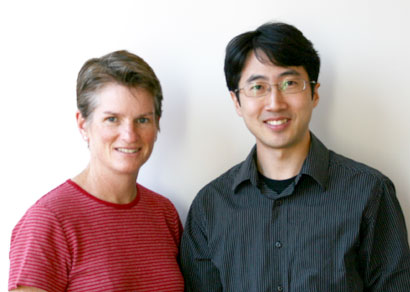Erin O’Shea, and Harold Kim
One of the main challenges in the postgenomic era is to understand how genetic information is translated into quantitative transcriptional output. Transcription factors bind DNA at specific sequence motifs and they bind more strongly to some sites than others. In eukaryotic cells, some binding sites are in nucleosome-free regions and are readily accessible to transcription factors, while some sites are in nucleosomal regions and require energy-driven chromatin remodeling to become accessible. Why did organisms evolve to maintain transcription factor binding sites under nucleosomes? How do the variable affinity and accessibility of transcription factor binding sites contribute to quantitatively distinct transcriptional outputs?
There have been attempts to predict gene expression profile from the arrangement of transcription factor binding sites in the promoter region. However, quantitative data that link transcription factor input to gene expression output, known as the “gene regulation function”, and models that include the effect of nucleosomes are missing. The goal of our research was (i) to characterize a eukaryotic promoter by its gene regulation function, especially in terms of how readily the gene is expressed (threshold) and how highly the gene can be expressed (maximum level), (ii) to rationalize these parameters with a mechanistic model that captures interactions among transcription factors, DNA and nucleosomes and (iii) to test whether the model can predict their quantitative changes when the interaction between the transcription factor and DNA is varied.
We studied the expression profile of a gene called PHO5 in budding yeast, which has well-defined transcription factor binding sites and nucleosome positions in its promoter. We modified the cell so that the transcription factor input can be dialed, and the resulting expression output from the downstream gene can be followed. Using fluorescent proteins as reporters of transcription factor and gene expression levels, we obtained the gene regulation function of the PHO5 promoter and investigated how sequence changes in transcription factor binding sites affect the gene regulation function.
We incorporated the basic concept of transcription factor causing nucleosome removal into a quantitative model: (i) a transcription factor binds to the nucleosome-free region, (ii) adjacent nucleosomes are removed, (iii) general transcription machinery can assemble more easily and (vi) more frequent transcription occurs. This model faithfully predicted the observed changes in the gene regulation function upon altering the transcription factor-DNA interaction. Further analysis of the model revealed that in the absence of nucleosomes, threshold and maximum level are correlated and cannot be tuned independently. Our work underscores the role of nucleosomes in diversification of gene expression profile and provides a nice model for predicting gene expression profile from the promoter structure.
Read paper in Nature Structural & Molecular Biology


